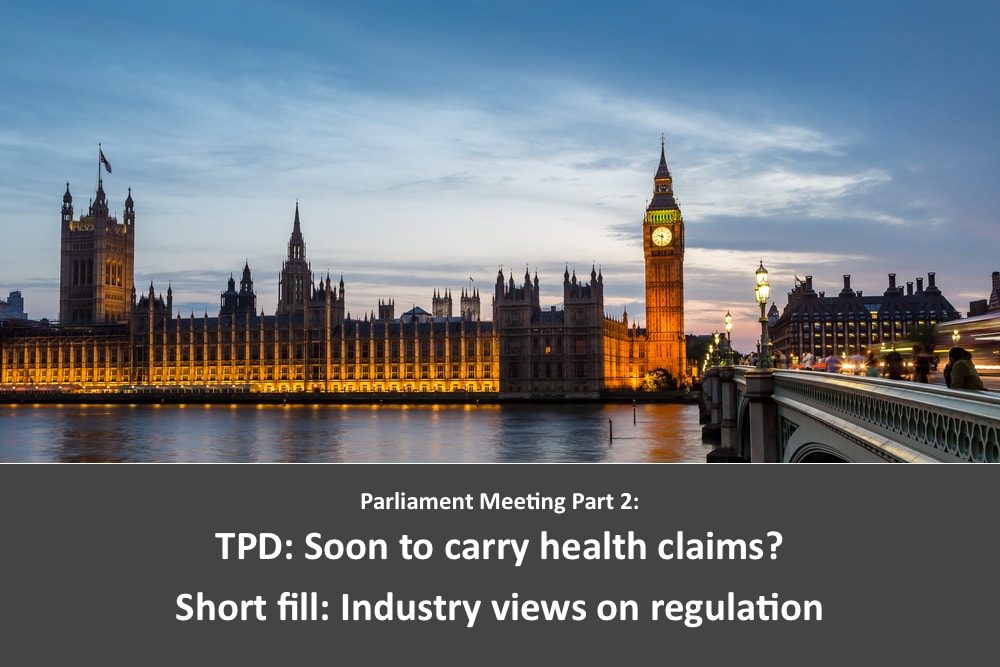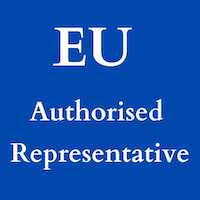4 Key Learnings from the UK Parliament Meetings
[vc_row][vc_column][vc_column_text]In 2018 the UK Parliament engaged in a discussion with government departments and the vape industry on a variety of hot vape-related topics. So what did they talk about and what did we learn from the proceedings?
We have covered 4 key learnings from the meetings in two parts. Part 1 was published in May. This is part 2.[/vc_column_text][vc_empty_space][/vc_column][/vc_row][vc_row][vc_column][vc_column_text]In Part 1:
1. MHRA to test marketed products for TPD compliance: What does it mean for the industry?
2. Medicinal e-cigs: NJOY announce application for medicinal e-cig
Click here for Part 1.
In Part 2:
3. TPD products: Soon to carry health claims?
4. Short fills: Industry views on regulation[/vc_column_text][vc_empty_space][/vc_column][/vc_row][vc_row][vc_column][vc_column_text]You should read this if you:
- Run a vape store (physical or online)
- Are a manufacturer, importer or wholesale/distributor of e-liquids or e-cigs
- Sell TPD e-cigs and e-liquids or short fills (‘shake n vape’) e-liquids in the UK
[/vc_column_text][vc_empty_space][/vc_column][/vc_row][vc_row][vc_column][vc_column_text css=”.vc_custom_1531219960423{padding: 20px !important;background-color: rgba(23,209,38,0.43) !important;*background-color: rgb(23,209,38) !important;border: 1px solid rgba(0,0,0,0.76) !important;}”]
About the Committee meetings
Interested parties – including members of the public – were invited to provide a written submission – or ‘evidence’ – to the Science and Technology Committee. The Committee reviewed the responses and subsequently invited a select few to participate in a face to face meeting with MPs. It was an opportunity for vape industry and MPs to openly discuss the hot topics.
What topics did they discuss?
Issues up for discussion included:
- Impact of electronic cigarettes on health and smoking cessation,
- suitability of the TRPR regulations
- Financial implications of a growing market on the vape industry and the NHS.
[/vc_column_text][vc_empty_space][/vc_column][/vc_row][vc_row][vc_column][vc_column_text]
3. TPD products: Soon to carry health claims?
Until now vape advertising rules have prohibited health claims such as “vaping [brand X ] is safer than than smoking cigarettes”. But that could change under proposed changes by the Advertising Standards Agency (ASA).[/vc_column_text][vc_empty_space][/vc_column][/vc_row][vc_row][vc_column][vc_column_text css=”.vc_custom_1531220451605{padding: 20px !important;background-color: rgba(35,215,221,0.45) !important;*background-color: rgb(35,215,221) !important;border: 1px solid rgba(0,0,0,0.84) !important;}”]
“the basis of our proposal [is] to allow marketers with a good product… to say things like it is potentially healthier or less harmful than smoking.”
Rob Morrison, Advertising Standards Agency (UK)
[/vc_column_text][vc_empty_space][/vc_column][/vc_row][vc_row][vc_column][vc_column_text]During the Committee meetings, Rob Morrison from the ASA explained to MPs that they were undertaking a consultation with the stakeholders that looked into the possibility of dropping the health claim ban.[/vc_column_text][vc_empty_space][/vc_column][/vc_row][vc_row][vc_column][vc_column_text]Morrison said:
“the basis of our proposal [is] to allow marketers with a good product… to say things like it is potentially healthier or less harmful than smoking.”
But there are specific conditions under which claims can be made. These conditions include:
- compliance with TPD,
- robust scientific evidence to back up the claim and
- comparative analysis with a tobacco product.
[/vc_column_text][vc_empty_space][/vc_column][/vc_row][vc_row][vc_column][vc_column_text]He speculated that the vape industry was perhaps ready to generate such data:
“Now that the TPD is in, we think that the market is probably getting to a point where some manufacturers will want to do that.”[/vc_column_text][vc_empty_space][/vc_column][/vc_row][vc_row][vc_column][vc_column_text]
What this means for the industry
If the proposed changes are approved then this would be great news for the vape industry. It would mean that, provided they met the conditions, manufacturers selling TPD compliant products could make health claims – a valuable marketing tool.
From a marketing perspective, this would give them the competitive advantage over short fill – or ‘shake n vape’ – manufacturers and may incentivise manufacturers to stay with TPD compliant products instead of going down the short fill route.[/vc_column_text][vc_empty_space][/vc_column][/vc_row][vc_row][vc_column][vc_column_text]But manufacturers will have to weigh up the costs and implications of meeting the specific conditions of making a health claim against the associated marketing benefits.[/vc_column_text][vc_empty_space][/vc_column][/vc_row][vc_row][vc_column][vc_column_text css=”.vc_custom_1531222203982{padding: 20px !important;background-color: rgba(72,234,102,0.55) !important;*background-color: rgb(72,234,102) !important;border: 1px solid rgba(0,0,0,0.75) !important;}”]
“Marketers will not be able to use generalised commentary by public health bodies about the benefits of e-cigarettes unless those claims are true for their specific products.”
Advertising Standards Agency on proposed rules for vape marketing
[/vc_column_text][vc_empty_space][/vc_column][/vc_row][vc_row][vc_column][vc_column_text]
The “e-cigarettes around 95% less harmful than tobacco” health claim in scope of consultation
Public Health England made the statement in 2015 after an independent review by experts. It was the first of its kind from a public health body and it became a widely used phrase in blogs and marketing material by brands in UK and internationally.
But if the proposed changes by ASA are approved, it may mean that the phrase could not be used so indiscriminately – for just any vape product.
Under the changes, like with other health claims, the “95% less harmful” claim may only be used for the marketing of specific products if supported by scientific evidence.
“Marketers will not be able to use generalised commentary by public health bodies about the benefits of e-cigarettes unless those claims are true for their specific products.” the ASA stated in a written submission.[/vc_column_text][vc_empty_space][/vc_column][/vc_row][vc_row][vc_column][vc_column_text]
What this means
As a result of the consultation, we may see is a 3-tier market where there is a clear choice for manufacturers:
- Make TPD compliant products marketed with health claims which are supported by product-specific evidence;
- TPD compliant products without health claims (no supporting evidence)
- Short fill without health claims
And looking into the future still, the 3-tier market could be simplified to just 2:
- TPD products with health claims (supported by general supporting evidence)
- Short fill without health claims
The ‘general supporting evidence’ refers to the complete body of evidence on the safety of e-cigarettes in general. If the rate at which research into e-cigarette safety continues, then the weight of evidence on e-cigarette safety will reach a point when health claims can be made on all e-cigarettes (TPD compliant ones, at least).[/vc_column_text][vc_empty_space][/vc_column][/vc_row][vc_row][vc_column][vc_column_text css=”.vc_custom_1531222777353{padding: 20px !important;background-color: rgba(0,0,0,0.06) !important;*background-color: rgb(0,0,0) !important;border: 1px solid rgba(0,0,0,0.75) !important;}”]
A choice for vapers
For vapers, this would provide a clear choice: buy a TPD compliant product with some reassurance of safety (in comparison with smoking) or a short fill without.[/vc_column_text][vc_empty_space][/vc_column][/vc_row][vc_row][vc_column][vc_column_text]
When would the proposed ASA changes come into effect?
If approved, the changes may come into effect this year – with a transition period to allow for manufacturers to make necessary changes to marketing materials and/or generate the supporting data.[/vc_column_text][vc_empty_space][/vc_column][/vc_row][vc_row][vc_column][vc_column_text]
4. Short fills: Industry Views on Regulation
How should short fills be regulated? This was a key topic up for discussion at the Committee meetings. The general consensus among the industry representatives including a vape trade association and big tobacco was that there should be some kind of regulation including testing and notification.[/vc_column_text][vc_empty_space][/vc_column][/vc_row][vc_row][vc_column][vc_column_text css=”.vc_custom_1531223514495{padding: 20px !important;background-color: rgba(71,221,68,0.51) !important;*background-color: rgb(71,221,68) !important;border: 1px solid rgba(0,0,0,0.8) !important;}”]
“In terms of consumer protection and public health, the risks are self-evident.”
UKVIA view on short fills
[/vc_column_text][vc_empty_space][/vc_column][/vc_row][vc_row][vc_column][vc_column_text]Selected comments from the meetings and written submissions follow:[/vc_column_text][vc_empty_space][/vc_column][/vc_row][vc_row][vc_column][vc_column_text]
UKVIA
The UKVIA highlighted the health risk of short fills with a reference to their own research into short fills on the market:
“Several UKVIA members have conducted tests on some of these products; the tests found 2,3-Pentanedione/Acetylpropionyl (an ingredient that is banned under TRPR, due to potential consumer risks) in a number of samples above the limit of detection for the testing sample. In terms of consumer protection and public health, the risks are self-evident. This is the illogical and potentially dangerous result of the current regulatory regime, created without industry involvement or input.”[/vc_column_text][vc_empty_space][/vc_column][/vc_row][vc_row][vc_column][vc_column_text]
Big Tobacco
[/vc_column_text][vc_empty_space][/vc_column][/vc_row][vc_row][vc_column][vc_column_text css=”.vc_custom_1531224690702{border-top-width: 1px !important;border-right-width: 1px !important;border-bottom-width: 1px !important;border-left-width: 1px !important;padding-top: 20px !important;padding-right: 20px !important;padding-bottom: 20px !important;padding-left: 20px !important;background-color: rgba(39,121,244,0.36) !important;*background-color: rgb(39,121,244) !important;border-left-style: solid !important;border-right-style: solid !important;border-top-style: solid !important;border-bottom-style: solid !important;}”]
“[short fills] it should be subject to the same stewardship and standards as nicotine-containing liquid.”
Dr O’connell from Fortem Ventures on short fill regulation
[/vc_column_text][vc_empty_space][/vc_column][/vc_row][vc_row][vc_column][vc_column_text]On the topic of the regulation of shake n vape, Dr Jones from Japan Tobacco International said:
“For me, as a scientist, that is a concern, because we do not know what is in that zero-nicotine flavoured liquid combination. Based on the principles of consumer protection, I think that zero-nicotine liquids should be regulated in the same way.”[/vc_column_text][vc_empty_space][/vc_column][/vc_row][vc_row][vc_column][vc_column_text]Dr O’connell from Fortem Ventures agreed:
“We think that, if the liquid is intended for vaping, it should be subject to the same stewardship and standards as nicotine-containing liquid.”[/vc_column_text][vc_empty_space][/vc_column][/vc_row][vc_row][vc_column][vc_column_text]
MHRA
The UK’s health agency – the MHRA – confirmed that short fills are regulated under the General Product Safety Regulation not the TRPR and so they do not need to be notified.[/vc_column_text][vc_empty_space][/vc_column][/vc_row][vc_row][vc_column][vc_column_text css=”.vc_custom_1531227595381{border-top-width: 1px !important;border-right-width: 1px !important;border-bottom-width: 1px !important;border-left-width: 1px !important;padding-top: 20px !important;padding-right: 20px !important;padding-bottom: 20px !important;padding-left: 20px !important;background-color: rgba(86,234,37,0.33) !important;*background-color: rgb(86,234,37) !important;border-left-style: solid !important;border-right-style: solid !important;border-top-style: solid !important;border-bottom-style: solid !important;}”]
“we will have to see the evidence as it emerges.”
Dr Hudson from MHRA on short fills
[/vc_column_text][vc_empty_space][/vc_column][/vc_row][vc_row][vc_column][vc_column_text]Dr Hudson, the Chief Executive, indicated that the safety of short fills was being closely monitored and that “we will have to see the evidence as it emerges.”
The ‘evidence’ Dr Hudson refers to is the research the MHRA are conducting, in collaboration with the Department of Health, Public Health England and Trading Standards Institute, into e-cigarettes in general. The research involves the lab testing of marketed short fills.
Read more about the compliance/safety checks by MHRA and Trading Standards in part 1.[/vc_column_text][vc_empty_space][/vc_column][/vc_row][vc_row][vc_column][vc_btn title=”Looking for affordable short fill testing? Click here.” style=”flat” shape=”square” color=”danger” align=”center” link=”url:https%3A%2F%2Fmedicpro.london%2Fshort-fill-shake-n-vape-testing%2F|||”][vc_empty_space][/vc_column][/vc_row][vc_row][vc_column][vc_column_text]
Voluntary notification of short fills
Some vape companies in the UK have asked the MHRA to consider a voluntary notification system for 0mg products. However, the agency responded with:
“Although a system of voluntary notification could be seen as improving consumer safety, in the absence of any legal obligation for producers under the TRPR, it is likely that it would also cause confusion for consumers, sections of the industry and enforcers as well as having the potential to create an unfair commercial advantage for those choosing to notify products.”
So for the time being, our advice is to not submit notifications to MHRA for 0mg products. However, other countries such as Czech Republic, do require notification of 0 mg products.[/vc_column_text][vc_empty_space][/vc_column][/vc_row][vc_row][vc_column][vc_btn title=”Contact us for full list of countries which require submission of 0mg notifications” style=”flat” shape=”square” color=”danger” align=”center” link=”url:https%3A%2F%2Fmedicpro.london%2Fcontact-us%2F|||”][vc_empty_space][/vc_column][/vc_row][vc_row][vc_column][vc_column_text]Resources
Science Committee Meeting official site
Read the ASA consultation here.
PHE “95% less harmful” statement
General Product Safety Regulations: Read the legislation[/vc_column_text][/vc_column][/vc_row][vc_row][vc_column][vc_empty_space][/vc_column][/vc_row]



Comments are closed here.